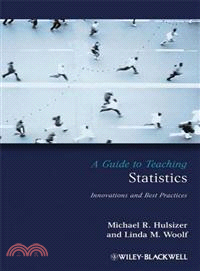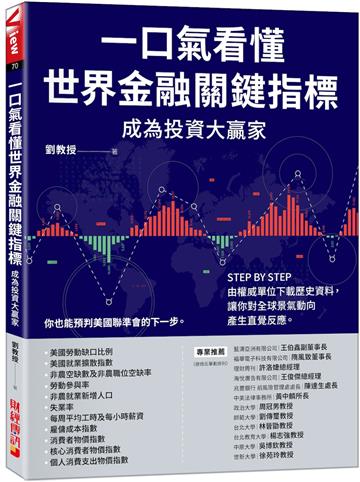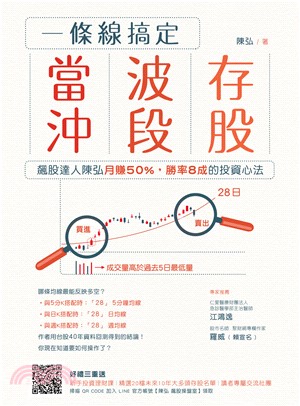Guide To Teaching Statistics
商品資訊
ISBN13:9781405155748
出版社:John Wiley & Sons Inc
作者:Hulsizer
出版日:2008/09/19
裝訂/頁數:平裝/280頁
規格:22.2cm*15.2cm*1.9cm (高/寬/厚)
商品簡介
作者簡介
目次
相關商品
商品簡介
A Guide to Teaching Statistics: Innovations and Best Practices addresses the critical aspects of teaching statistics to undergraduate students, acting as an invaluable tool for both novice and seasoned teachers of statistics.
Guidance on textbook selection, syllabus construction, and course outline
Classroom exercises, computer applications, and Internet resources designed to promote active learning
Tips for incorporating real data into course content
Recommendations on integrating ethics and diversity topics into statistics education
Strategies to assess student's statistical literacy, thinking, and reasoning skills
Additional material online at www.teachstats.org
Guidance on textbook selection, syllabus construction, and course outline
Classroom exercises, computer applications, and Internet resources designed to promote active learning
Tips for incorporating real data into course content
Recommendations on integrating ethics and diversity topics into statistics education
Strategies to assess student's statistical literacy, thinking, and reasoning skills
Additional material online at www.teachstats.org
作者簡介
Michael R. Hulsizer is Associate Professor of Experimental Psychology at Webster University in St. Louis, Missouri, where he was honored with the prestigious William T. Kemper Award for Excellence in Teaching (2002). He has attended numerous National Institute on the Teaching of Psychology conferences and has won awards for posters presented at the conference. Michael has coauthored several teaching resources available at the Office of Teaching Resources in Psychology – Online. In addition, he recently contributed a chapter with Linda on incorporating diversity into research methods for Best Practices for Teaching Statistics and Research Methods in the Behavioral Sciences. Michael has also authored articles on mass violence, hate groups, and interpersonal aggression.
Linda M. Woolf is Professor of Experimental and Peace Psychology at Webster University. Linda is the recipient of several teaching awards including the 1988 Early Career Award from the Society for the Teaching of Psychology (Division 2, APA), Emerson Electric Excellence in Teaching Award (1990, 2000), and William T. Kemper Award for Excellence in Teaching (2000). She has authored numerous curriculum resources, book chapters, and journal articles concerning international psychology, peace psychology, mass violence, human rights, and research methods. Linda is Past-President of the Society for the Study of Peace, Conflict, and Violence (Division 48, APA) and former Secretary and Newsletter Editor for the Society for the Teaching of Psychology.
Linda M. Woolf is Professor of Experimental and Peace Psychology at Webster University. Linda is the recipient of several teaching awards including the 1988 Early Career Award from the Society for the Teaching of Psychology (Division 2, APA), Emerson Electric Excellence in Teaching Award (1990, 2000), and William T. Kemper Award for Excellence in Teaching (2000). She has authored numerous curriculum resources, book chapters, and journal articles concerning international psychology, peace psychology, mass violence, human rights, and research methods. Linda is Past-President of the Society for the Study of Peace, Conflict, and Violence (Division 48, APA) and former Secretary and Newsletter Editor for the Society for the Teaching of Psychology.
目次
Series Editors’ Preface.
Preface.
Part I Course Preparation.
1 Teaching Statistics: A Beginning.
So Why Teach Statistics?
Historical Pedagogical Controversies.
Who should teach statistics?
Statistics labs and related technology.
Content of statistics courses.
Statistics in Relation to the Discipline.
Sequence of the Class and Topics.
Introducing Research Methods within the Context of Statistics.
Student Populations.
Mathematical ability.
Cognitive ability and learning styles.
Self-efficacy and motivation.
Gender.
Helping Your Students Survive Statistics.
Conclusion.
2 Nuts and Bolts of Teaching Statistics.
Syllabus Construction.
Textbook Selection.
Conceptual orientation.
Level of difficulty.
Chapter topics and organization.
Core formulas and vocabulary.
Type of data sets/quality of the exercises.
Traditional Versus Electronic Textbooks.
Supplemental Materials.
Study guides.
Companion Web sites.
Computer tutorials.
Electronic Discussion Boards.
Multimedia Tools.
Presentation technology.
Interactive applications: Java applets, Flash, Shockwave, and HTML.
Multimedia simulation programs.
Conclusion.
Part II Theoretical and Pedagogical Concerns.
3 Educational Reform in Statistics.
Educational Reform.
Statistically Educated Students.
Statistical Literacy.
Knowledge elements.
Dispositional elements.
Statistical Thinking.
Statistical Reasoning.
Misconceptions Impacting the Development of Literacy, Thinking, and Reasoning.
Final Thoughts on Statistical Literacy, Thinking, and Reasoning.
Assessment.
What is the role of assessment?
What is the role of authentic assessment?
Assessment and learning outcomes or goals.
Conclusion.
4 In the Classroom.
Conceptual Learning, Active Learning, and Real Data.
Conceptual learning versus rote memorization.
Active learning.
Real data.
Instructional Techniques.
Lecture.
The use of questions.
Practice problems and examples.
Journal assignments.
Activities and demonstrations.
Writing assignments.
Concept maps.
Cooperative learning.
Projects.
Assessment.
Principles of effective assessment.
Mastery learning.
Confronting Fear and Anxiety.
Conclusion.
Part III Teaching Specific Statistical Concepts.
5 Descriptive Statistics and Bivariate Distributions.
Graphing Data.
The use of graphs in science.
Elements of good design.
Human graphical perception.
Available graphing methods.
Software design.
Normal Distribution.
Measures of Central Tendency.
Measures of Variability.
Correlation.
Simple Linear Regression.
Computer Applications.
Conclusion.
6 Teaching Hypothesis Testing.
Samples, Sampling Distributions, and the Central Limit Theorem.
Confidence Intervals.
Introduction to Null Hypothesis Testing.
Additional Introduction to Hypothesis Testing Concepts.
Power.
Effect sizes.
Type I and Type II errors.
Analysis of Variance.
Introduction to ANOVA.
Violating ANOVA assumptions.
Factorial ANOVA.
General linear model.
The Debate Surrounding Null Hypothesis Significance Testing.
Nonparametric Statistics.
Computer Applications.
Conclusion.
Part IV Advanced Topics and Approaches.
7 Data Analysis in Statistical Education.
Teaching with Statistical Software Tools.
Data Analysis Packages.
SPSS.
Microsoft Excel.
Other commercial data analysis programs.
Comparing data analysis programs.
Data Analysis Software Textbooks.
Using Data Sets in the Classroom.
Artificial data sets for the classroom.
Reality-based data sets.
Finding appropriate reality-based data sets.
Drawbacks to using real data sets.
Conclusion.
8 Endings and Beginnings.
Multivariate Statistics.
Multiple regression.
Logistic regression.
Additional multivariate techniques.
Special Topics.
Ethics.
Diversity.
Online Statistical Education.
Finishing up Any Statistics Course.
Final Thoughts.
References.
Index.
Preface.
Part I Course Preparation.
1 Teaching Statistics: A Beginning.
So Why Teach Statistics?
Historical Pedagogical Controversies.
Who should teach statistics?
Statistics labs and related technology.
Content of statistics courses.
Statistics in Relation to the Discipline.
Sequence of the Class and Topics.
Introducing Research Methods within the Context of Statistics.
Student Populations.
Mathematical ability.
Cognitive ability and learning styles.
Self-efficacy and motivation.
Gender.
Helping Your Students Survive Statistics.
Conclusion.
2 Nuts and Bolts of Teaching Statistics.
Syllabus Construction.
Textbook Selection.
Conceptual orientation.
Level of difficulty.
Chapter topics and organization.
Core formulas and vocabulary.
Type of data sets/quality of the exercises.
Traditional Versus Electronic Textbooks.
Supplemental Materials.
Study guides.
Companion Web sites.
Computer tutorials.
Electronic Discussion Boards.
Multimedia Tools.
Presentation technology.
Interactive applications: Java applets, Flash, Shockwave, and HTML.
Multimedia simulation programs.
Conclusion.
Part II Theoretical and Pedagogical Concerns.
3 Educational Reform in Statistics.
Educational Reform.
Statistically Educated Students.
Statistical Literacy.
Knowledge elements.
Dispositional elements.
Statistical Thinking.
Statistical Reasoning.
Misconceptions Impacting the Development of Literacy, Thinking, and Reasoning.
Final Thoughts on Statistical Literacy, Thinking, and Reasoning.
Assessment.
What is the role of assessment?
What is the role of authentic assessment?
Assessment and learning outcomes or goals.
Conclusion.
4 In the Classroom.
Conceptual Learning, Active Learning, and Real Data.
Conceptual learning versus rote memorization.
Active learning.
Real data.
Instructional Techniques.
Lecture.
The use of questions.
Practice problems and examples.
Journal assignments.
Activities and demonstrations.
Writing assignments.
Concept maps.
Cooperative learning.
Projects.
Assessment.
Principles of effective assessment.
Mastery learning.
Confronting Fear and Anxiety.
Conclusion.
Part III Teaching Specific Statistical Concepts.
5 Descriptive Statistics and Bivariate Distributions.
Graphing Data.
The use of graphs in science.
Elements of good design.
Human graphical perception.
Available graphing methods.
Software design.
Normal Distribution.
Measures of Central Tendency.
Measures of Variability.
Correlation.
Simple Linear Regression.
Computer Applications.
Conclusion.
6 Teaching Hypothesis Testing.
Samples, Sampling Distributions, and the Central Limit Theorem.
Confidence Intervals.
Introduction to Null Hypothesis Testing.
Additional Introduction to Hypothesis Testing Concepts.
Power.
Effect sizes.
Type I and Type II errors.
Analysis of Variance.
Introduction to ANOVA.
Violating ANOVA assumptions.
Factorial ANOVA.
General linear model.
The Debate Surrounding Null Hypothesis Significance Testing.
Nonparametric Statistics.
Computer Applications.
Conclusion.
Part IV Advanced Topics and Approaches.
7 Data Analysis in Statistical Education.
Teaching with Statistical Software Tools.
Data Analysis Packages.
SPSS.
Microsoft Excel.
Other commercial data analysis programs.
Comparing data analysis programs.
Data Analysis Software Textbooks.
Using Data Sets in the Classroom.
Artificial data sets for the classroom.
Reality-based data sets.
Finding appropriate reality-based data sets.
Drawbacks to using real data sets.
Conclusion.
8 Endings and Beginnings.
Multivariate Statistics.
Multiple regression.
Logistic regression.
Additional multivariate techniques.
Special Topics.
Ethics.
Diversity.
Online Statistical Education.
Finishing up Any Statistics Course.
Final Thoughts.
References.
Index.
主題書展
更多
主題書展
更多書展今日66折
您曾經瀏覽過的商品
購物須知
外文書商品之書封,為出版社提供之樣本。實際出貨商品,以出版社所提供之現有版本為主。部份書籍,因出版社供應狀況特殊,匯率將依實際狀況做調整。
無庫存之商品,在您完成訂單程序之後,將以空運的方式為你下單調貨。為了縮短等待的時間,建議您將外文書與其他商品分開下單,以獲得最快的取貨速度,平均調貨時間為1~2個月。
為了保護您的權益,「三民網路書店」提供會員七日商品鑑賞期(收到商品為起始日)。
若要辦理退貨,請在商品鑑賞期內寄回,且商品必須是全新狀態與完整包裝(商品、附件、發票、隨貨贈品等)否則恕不接受退貨。
























